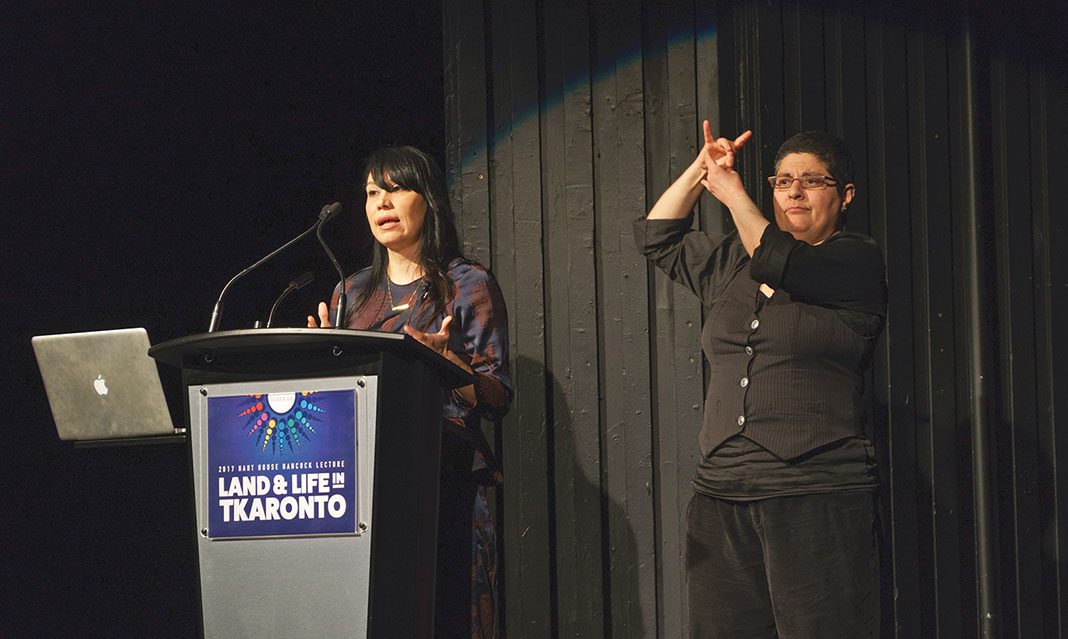Last Tuesday, Susan Blight delivered Hart House’s annual Hancock Lecture, titled “Land and Life in Tkaronto: New Solidarities Toward a Decolonial Future.” Blight is an Anishinaabe artist, filmmaker, arts educator, and activist from Couchiching First Nation. She is nationally recognized for her work in language revitalization. Blight is also a presidential appointee to the Hart House Board of Stewards, and organizes U of T’s annual Indigenous Education Week.
As the country celebrates its 150th anniversary, Blight sheds light upon Toronto’s 15,000 years of history. She began the lecture by introducing her clan and origins, acknowledging the Indigenous territory that we occupy. The intent of Blight’s lecture was to promote Anishinaabe land, history, knowledge, and particularly, the language—Anishinaabemowin.
In 2013, Blight co-founded The Ogimaa Mikana Project with Anishinaabe writer and educator Hayden King. The project consists of Anishinaabe activists and artists working in Toronto to reclaim the streets and landmarks of Anishinaabe territory with the use of Anishinaabemowin. The main objectives of the project are reclaiming and renaming. This is done by replacing official street, park, and landmark signage with the original Anishinaabe versions. For example, “Spadina” would be changed to the original Ishpadinaa.
“At the centre of the project is the revitalization of the Anishinaabemowin,” noted Blight, “[…] as a pushback against the settler-colonial system in Canada—a system whose objective with regards to Indigenous peoples has not changed.”
Blight acknowledged the dispossession of Indigenous peoples from their land and resources, and how the state’s assimilation policies resulted in devastating effects on Indigenous languages. The Ogimaa Mikana Project aims to remind non-Indigenous people of their place on Indigenous land. It also seeks to reinforce awareness of Indigenous presence in Canada. Moreover, the project hopes to initiate communication with other Anishinaabe in Toronto—a city that can feel alienating to Indigenous peoples with its endless signage that represents the settler-colonial system.
Blight is interested in resurging Toronto’s Indigenous presence by returning these signs back to their original names. She emphasized that although Mississauga, Etobicoke, and Toronto all have associations with Indigenous languages, the history of the words are not recognized today. Blight quotes Métis artist Christi Belcourt, who calls these names “empty references bereft of the burden of Canada’s colonial history.”
The name “Toronto” is derived from the Mohawk word Tkaronto, which translates to “the place in the water where the trees are standing.”
“When I think of Toronto […]” said Blight, “I think Tkaronto.”
Toronto is known for its multiculturalism, with more than half of the population consisting of foreigners. But Blight highlighted a lesser-known fact about Toronto—it is home to approximately 27,000 Indigenous people.
The Ogimaa Mikana project intends to reach this population, spreading awareness of the Indigenous people and their struggle, and encouraging partnerships between Indigenous people and other communities. Blight mentioned feelings of solidarity between Black Lives Matter Toronto and Indigenous activists during the protests regarding the police shooting of Andrew Loku in 2015. Blight named Turtle Island as a site where Indigenous and non-Indigenous communities could unite in an act of “shared oppression.” Blight discussed the importance of Tkaronto as having the potential to work across cultural differences and build relationships across different groups.
“The goal is not for everyone to merely swap spots on a settler-colonial triad,” she explained. “[…] The goal is to break the relentless structuring of the triad.”
Blight emphasized how different groups can live in peace, as long as they respect each other’s rights to mutual autonomy and respect the land that they occupy.
“All of us living in Tkaronto eat out of the same dish, but it only has one spoon […] we are responsible for making sure that the dish is always replenished, and we must reject greed by sharing that one spoon among us.”



